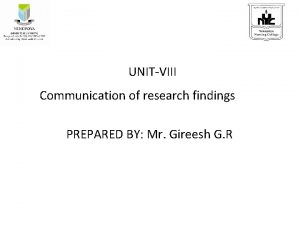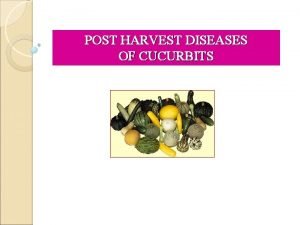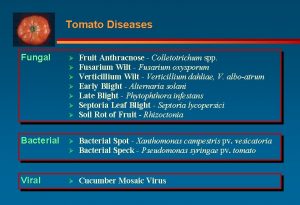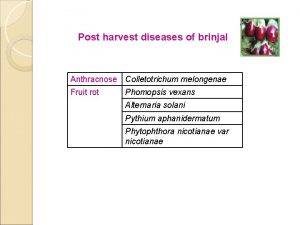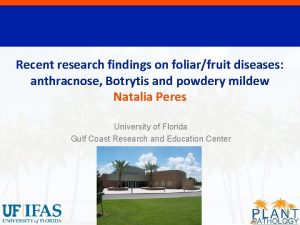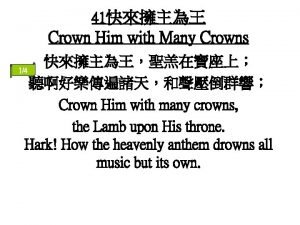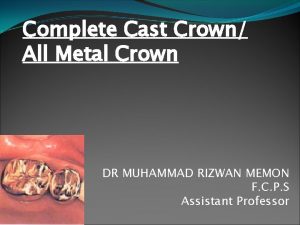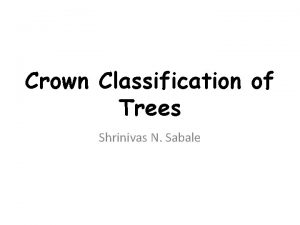Recent research findings on crown diseases Macrophomina Colletotrichum























- Slides: 23

Recent research findings on crown diseases: Macrophomina, Colletotrichum and Phytophthora Natalia A. Peres, Jim Mertely, and Juliana Baggio UF, Gulf Coast REC Joe Noling UF, Citrus REC

A crown rot… is a crown rot

Well, not really… 2016 -17 diagnostic clinics snapshot 17% 39% 32% 12% Colletotrichum acutatum Macrophomina phaseolina Colletotrichum gloeosporioides Phytophthora cactorum

Root Necrosis/Crown Rot (Colletotrichum acutatum)

Early season disease problems in FL 2016 -17: C. acutatum 2015 -16: C. acutatum 2014 -15: C. acutatum 2013 -14: C. acutatum 2012 -13: C. acutatum (SMYEV and SMo. V) 2007 -08: C. gloeosporioides 2004 -05: C. acutatum

2016 -17 Fungicide dip trials GCREC - Balm Plants root-inoculated with C. acutatum

C. acutatum plant dip trial 2016 -17

Colletotrichum Crown Rot and Phytophthora Crown Rot Symptoms nearly identical and similar to charcoal rot caused by Macrophomina phaseolina

Colletotrichum / Phytophthora crown rots ü Both favored by warm weather ü Colletotrichum: high incidence in local summer nurseries ü Production of transplants in northern states greatly reduced disease ü Low incidence (1 -5%) still observed: inoculum from other hosts ü Phytophthora: nursery infected transplants

Current recommendations for Colletotrichum / Phytophthora control ü Correct diagnosis! ü Colletotrichum ü Preventative captan applications (susceptible cv) ü Phytophthora ü one or two applications of Ridomil after plant establishment ü regular applications of phosphorous acid or phosphite materials throughout the season

Fungicides recommended for Colletotrichum Crown Rot control ü Captan (captan) – Group M 4 ü ü Abound (azoxystrobin) – Group 11 Cabrio (pyraclostrobin) – Group 11 Flint (tryfloxistrobin) – Group 11 Evito (fluoxastrobin) – Group 11 ü Topsin (thiophanate-methyl – Group 1 ü Switch (cyprodinil + fludioxonil) – 9 + 12

50 45 40 35 30 25 20 15 10 5 0 2016 2015 2013 2011 2010 2009 2007 2006 2004 2003 2002 2001 2000 1999 1998 1997 1996 Resistant 1995 Number of isolates Screening of C. gloeosporioides isolates for sensitivity to strobilurin fungicides* *Abound, Cabrio, Flint, etc… *All isolates resistant to strobilurin fungicides were also resistant to Topsin

Phytophthora drip trial 2016 -17

Emergence of Ridomil resistance Ridomil Sensitive Resistant 2016 -17 FL season Clinic Samples P. cactorum P. nicotianae 10% 14% 86% n=47 90%

Charcoal Rot caused by Macrophomina phaseolina * Similar to symptoms caused by Colletotrichum and Phytophthora

Charcoal Rot ü First diagnosed in Florida in 2001; in CA in 2005 ü Optimum conditions – high temperatures (>78 o. F)* and high O 2 concentration in the soil ü Survives in the soil as microsclerotia – viable for up to 3 years Fumigation

Dover fumigation trial 2016 -17 Macrophomina evaluation Treatment (rate) Plastic/Method Number of Macrophomina colonies/ 3 ml kaykob bundle Center of Bed Side of Bed 1. Me. Br 50 Shank + VIF 0. 0 d 2. Telone C 35 (30 gpta) Shank + VIF 0. 1 d 0. 0 d 3. Pic. Clor 60 (300 lb/ta) Shank + VIF 122. 1 b 76. 5 bc 4. Pic 80 (23 gpta) Shank + VIF 0 d 5. Pic 100 (21. 6 gpta) Shank + VIF 10. 9 c 23. 6 bc Drip + VIF 0. 3 d 0. 6 cd Shank + TIF 247. 9 a 374. 1 a 8. DMDS EC + Pic EC (30 gpta) Drip + TIF 0. 1 d 76. 0 bc 9. Dominus (30 gpta) Drip + VIF 0. 4 d 137. 5 b 10. Untreated control -- 529. 4 a 483. 8 a 6. Kpam (62 gpta) 7. DMDS + Pic (30 gpta)

Macrophomina Chemigation trial 2016 -17

Crop destruction trial • 60% mortality at end of 2015 -16 season • Field previously fumigated with Telone • Planted with highly susceptible cultivar Albion 2016 -17 season

Integrated approach for Macrophomina management üCrop destruction üPre-plant fumigation üCultivar selection üCrop residue removal when re-using plastic

Cultivar evaluations for crown rot diseases Disease Causal agent Colletotrichum crown rot Colletotrichum gloeosporioides Phytophthora crown rot Phytophthora cactorum Charcoal rot Macrophomina phaseolina Festival Radiance Winterstar FL-127 (Sensation) S S MS MR (52%) (50%) (40%) (27%) R HS S HS (5%) (50%) (36%) (67%) S MS MR MR (95%) (52%) (12%) (20%) * Knowing your cultivar susceptibility helps with diagnosis!!

GCREC Strawberry Pathology Team

 Macrophomina
Macrophomina Qualitative paper example
Qualitative paper example Findings in research
Findings in research Communication of research finding
Communication of research finding Qualitative and quantitative data analysis
Qualitative and quantitative data analysis Results and discussion in research
Results and discussion in research Findings of qualitative research
Findings of qualitative research Example of applied research
Example of applied research Translating research findings to clinical nursing practice
Translating research findings to clinical nursing practice Students diversity in motivation essay
Students diversity in motivation essay Reporting research findings
Reporting research findings Presenting research findings
Presenting research findings Recent trends in ic engine
Recent trends in ic engine Recent developments in ict
Recent developments in ict Recent developments in object detection
Recent developments in object detection Many recent college graduates have faced
Many recent college graduates have faced Recent trends in foreign trade
Recent trends in foreign trade Importance of scanning and skimming
Importance of scanning and skimming Current trends in project management
Current trends in project management Recent demographic changes in the uk
Recent demographic changes in the uk Myips schoology login
Myips schoology login During a recent police investigation
During a recent police investigation After kato's serious motorcycle accident
After kato's serious motorcycle accident A friend emails you the results of a recent high school
A friend emails you the results of a recent high school



